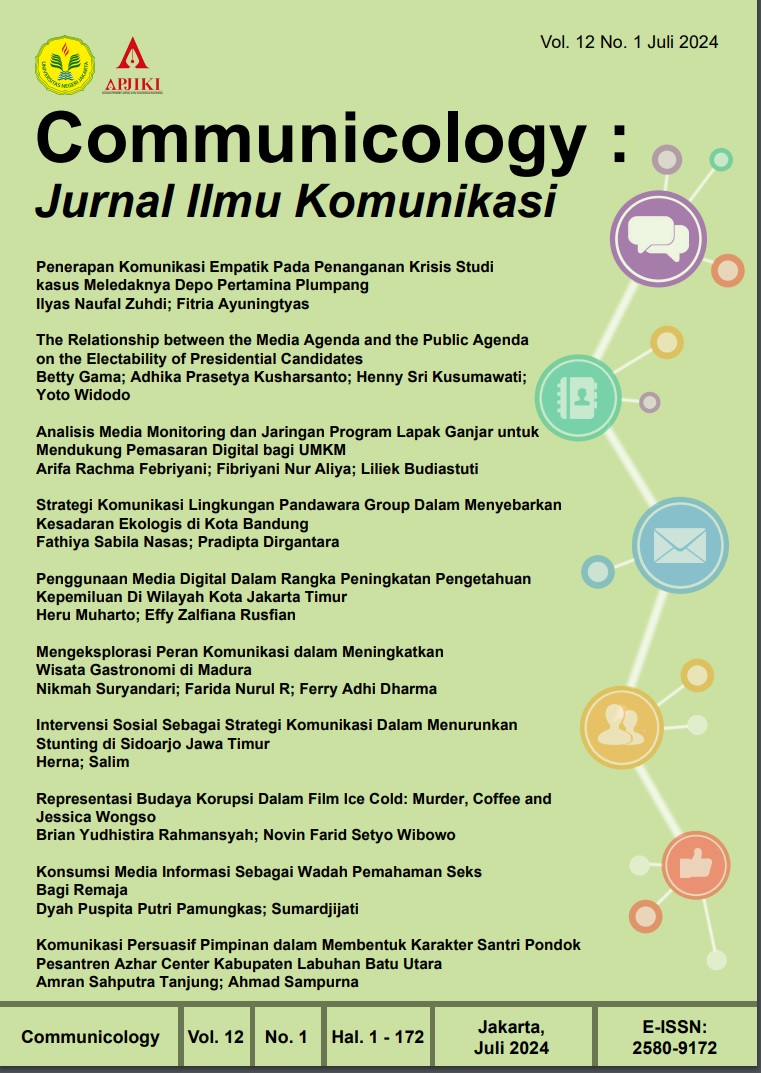Intervensi Sosial Sebagai Strategi Komunikasi Dalam Menurunkan Stunting di Sidoarjo Jawa Timur
DOI:
https://doi.org/10.21009/COMM.032.07Keywords:
Communication Intervention, Communication Strategy, StuntingAbstract
The stunting rate decreased by 2.8%, which was 21.6% in 2022 compared to 24.4% in
2021. The decline is a positive development, but it is still above the threshold set by the
World Health Organization (WHO) which should not exceed 20%. This shows that the
problem of stunting in Indonesia still requires serious attention. The purpose of the
study was to understand social intervention as one of the communication strategies in
reducing stunting rates in Sidoarjo Regency. Interventions in communication for social
and behavioral change include various methods such as interpersonal communication,
the utilization of mass media, and community mobilization and its social aspects.
Qualitative research approach with constructivism paradigm. The data collection
method was an in-depth interview with 4 resource persons, namely a public relations
officer of the Sidoarjo Regency Health Office and three mothers who were the target
audience for reducing stunting rates. The results showed that efforts to reduce stunting
were carried out through two social interventions, namely specific nutrition
interventions to address direct causes and nutrition-sensitive interventions to address
indirect causes. Social interventions are carried out in a convergent manner with an
emphasis on handling the causes of nutritional problems. Social and behavioral change
communication approaches are used to raise awareness about stunting so as to
encourage pregnant women and stunted children to improve nutrition and behave
healthily.
References
Asia, E. (2017). ADB Annual Report 2016. In ADB Annual Report 2016. https://doi.org/10.22617/fls178712
Bender, G. W. (2021). Strategi Komunikasi Kampanye Sadar Stunting 2021 Melalui Kol. Pariwara, 2(1).
Bhutta, Z. A., Das, J. K., & Rizvi, A. (2013). The Lancet Nutrition Interventions Review Group, and the Maternal and Child Nutrition Study Group. Evidence-Based Interventions for Improvement of Maternal and Child Nutrition: What Can Be Done and at What Cost? 382, 452–477. https://doi.org/https://doi.org/10.1016/S0140-6736(13)60996-4
Black, R. E., Morris, S. S., & Bryce, J. (2013). Where and Why Are 10 Million Children Dying Every Year? Lancet, 361, 2226–2234. https://doi.org/https://doi.org/10.1016/S0140-6736(03)13779-8
Dewey, K. G., & Adu-Afarwah, S. (2010). Systematic Review of the Efficacy and Effectiveness of Complementary Feeding Interventions in Developing Countries. Maternal and Childhood Nutrition, 4, 24–85. https://doi.org/https://doi.org/10.1111/j.1740-8709.2007.00124.x
Hall, C., Ahmad, S., Benjamin, Crookston Cudjoe, B. M. R. H., Linehan, M., Joshua, W., Scott, T., & Kirk, D. (2018). Addressing Communications Campaign Development Challenges to Reduce Stunting in Indonesia. Health, Vol.10 No. https://doi.org/10.4236/health.2018.1012133
Miles, M. B., Huberman, A. M., & Saldana, J. (2014). Qualitative Data Analysis A Methods Sourcebook (3rd ed.). Sage Publications.
Munira, S. (2022). Hasil Survei Status Gizi Indonesia. In Kementerian Kesehatan Republik Indonesia. https://promkes.kemkes.go.id/materi-hasil-survei-status-gizi-indonesia-ssgi-2022
Pergiwati. (2023). Wujudkan Gresik Bebas Stunting. sumber: jatimnow.com%0Ahttps://jatimnow.com/baca-63475-wujudkan-gresik-bebas-stunting-bupati-dan-ketua-tp-pkk-berikan-makanan-tambahan
Roberto, I., Kasnawi, T., & Unde, A. A. (2016). Strategi Komunikasi Penyuluhan Program KB Vasektomi untuk Masyarakat Miskin Perkotaan di Makassar. Jurnal Ilmu Sosial Dan Ilmu Politik Universitas Hasanuddin, 2(2), 106–115. http://journal.unhas.ac.id/index.php/kritis
Sanghvi, T., Haque, R., & Roy, S., et al. (2016). Achieving Behavior Change at Scale: Alive & Thrive’s Infant and Young Child Feeding Programme in Bangladesh. Food and Nutrition Bulletin, 141-54.
Smith, R. D. (n.d.). Strategic Planning for Public Relations. Taylor and Francis.
Wilkin, K. G., Tufte, T., & Obregon, R. (2014). The Handbook of Development Communication and Social Change. Wiley Blackwell.
Downloads
Published
How to Cite
Issue
Section
License
Authors who publish with this Journal agree to the following terms:
- Author retain copyright and grant the journal right of first publication with the work simultaneously licensed under a creative commons attribution licensethat allow others to share the work within an acknowledgement of the work’s authorship and initial publication of this journal.
- Authors are able to enter into separate, additional contractual arrangementfor the non-exclusive distribution of the journal’s published version of the work (e.g. acknowledgement of its initial publication in this journal).
- Authors are permitted and encouraged to post their work online(e.g. in institutional repositories or on their websites) prior to and during the submission process, as it can lead to productive exchanges, as well as earlier and greater citation of published works.
Users/public use of this website will be licensed to CC BY





